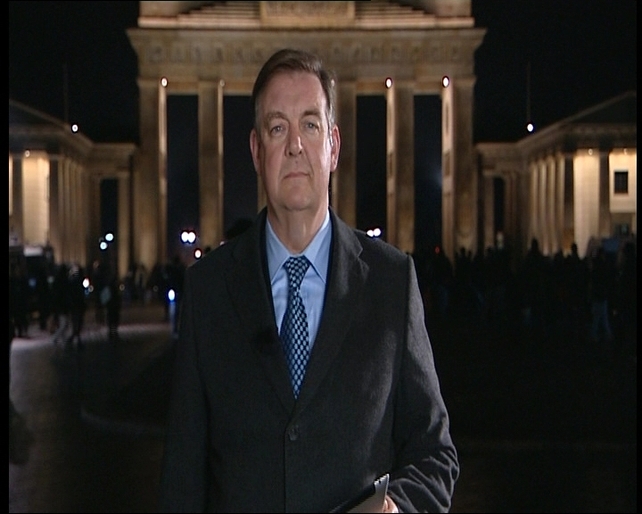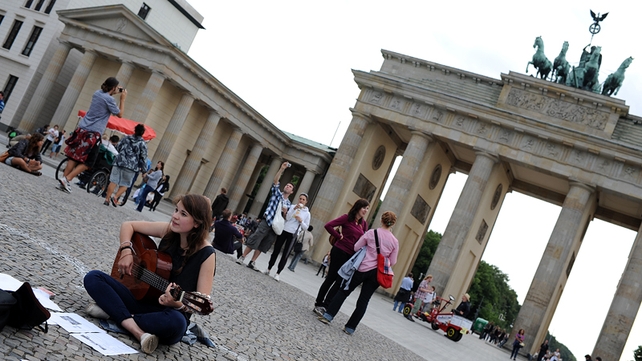Our trip, operated by Fat Tyre Bike Tours, took us on a journey through the turbulent history of one of the great cities of Europe.
Hitler, Ciarán tells us, wanted to rebuild and remodel Berlin as the physical expression of Nazi domination of Europe. Elaborate plans were drawn up for a monumental new capital to be called Germania. The scheme, of course, was never realised except for the construction of four small stone lodges at a busy traffic roundabout in the Tiergarten, the large and heavily wooded park which extends into the very centre of the city, right up to the famous Brandenburg Gate.

Bryan Dobson reporting from Berlin
As we rest on the handlebars of our bicycles with the traffic hurtling by, Ciarán points to the bullet holes in the small lodge buildings; a reminder of the bloody closing stages of the Battle for Berlin in May 1945. In just a few weeks tens of thousands died as Russian troops took control of the city, building by building and street by street.
Everywhere in Berlin are reminders of its extraordinary history, from German unification in the mid 19th century to the modern Germany of Angela Merkel. The city bears the scars of war, occupation and partition. Its recent rebirth is evident in the restoration of historic buildings like the Bundestag and the rebuilding of the once desolate Cold War no-man’s-land of Potsdamer Platz. There can be few cities with as dramatic a story to tell.
Berlin today could not be more removed from Hitler’s vision for Germania. Many of the grand buildings have or are being restored and in the case of the long demolished royal palace reconstructed in replica on the same site. The result is that parts of central Berlin, twenty five years after reunification, still resemble a giant construction site.
Elsewhere the work has been completed and the transformation is spectacular. A visit to the Bundestag, the German parliament, is a good place to begin. Entry is free but it is advisable to book on line in advance, so popular is this iconic building with German and foreign visitors alike.
Entry gives direct access to the roof dome, a huge glass and steel structure that seems to float above the old 19th century building and from which Berlin stretches away in all directions. Designed by British architect Norman Foster, the dome is not just a striking addition the Berlin skyline. It also illuminates the parliamentary chamber below, circulates air throughout the building and collects and recycles rain water. An audio guide tells you about the building, the dome and what can be seen of the city below.
Close by is the new government district, including the Chancellor’s office, the parliamentary committees building and Bundestag library; a striking ensemble of modern architectural statements.
All of this has come about since reunification in 1989. For almost thirty years Berlin was a divided city. In 1962 East Germany, alarmed at the large number of its citizens who were abandoning the communist state for the capitalist west via Berlin, built a wall to halt the exodus. The barrier ran across busy streets, through parks and graveyards, along canals and rivers, down quiet avenues; dividing communities and families, cutting off workers from their workplaces and children from their schools.
A few sections of the Berlin Wall remain but gone are the watchtowers, anti-tank barriers, the barbed wire, the ‘death zone’, the spotlights and the inner wall.
It’s full extent can now only be appreciated through photographs or perhaps by a visit to Bernauer Strasse. Here the city has made its own memorial to the wall and to those who died trying to escape East Berlin. The street here was divided in two with houses on one side in the communist east and those opposite in West Berlin. Buildings on the east side were eventually demolished as the wall became more elaborate, all of which is detailed in the excellent information panels at the permanent outdoor exhibition on the site. Sections of the wall are still in place along with just one of the many watchtowers that once lined the border.
The story of everyday life in East Berlin is told in the Museum in der Kulturebrauerei, a former brewery converted into a cultural centre. Here are accounts of work, education, home life and leisure in the former German Democratic Republic. The constant shortages of even basic products is recalled, highlighting the gap between the promise of communism and the reality. The museum, which is also free, exposes the elaborate state security system in which East Germans were spied on by neighbours, friends and sometimes their own families. Once confidential government documents are also on display, including one from a senior economic advisor in the late 1980’s telling his superiors that the country was virtually bankrupt. Within months the wall had come down and the GDR was no more.
Up to that point there was only limited access through the wall, most famously at Checkpoint Charlie. At the time it was the front line in the Cold War but today it is a rather tacky tourist trap. Close by and worth much more of your time and attention is the exhibition Topography of Terror, entry to which is also free. Housed in a low building on the site of the former headquarters of the Nazi secret police, the Gestapo, the exhibition lays bare the horrors of Hitler’s Germany.
Using photographs from the period with captions and explanations which plainly recount the facts, the exhibition explains Hitler’s rise to power through the elimination of internal opposition and the Nazi’s infiltration of every section of society. There are no artefacts or mementos here, just a gripping and detailed description of Nazi German’s rise and eventual destruction, and of the genocide it visited upon Europe. You come face to face with the men and women responsible for sending millions into slave labour, for the concentration camps, the death squads and the whole apparatus of Nazi occupation, terror, violence and murder.

Berlin is a thriving city of culture
Also targeted by the Nazis was Berlin’s vibrant artistic and theatre culture. Today it thrives once again in the form of cabarets, comedy, reviews, art house cinema and exhibitions. Check out the Chamaeleon Theatre on Rosenthaler Strasse in the Scheunenviertel area where the extraordinary Wonderkammer show continues until the end February 2016. Featuring hair-raising acrobatics combined with drama and comedy it is a show that seems to reflect the very soul of Berlin.
The German capital is a city of districts. There is a historic centre, the Mitte or middle, and this is where most of the best known visitor attractions are concentrated. But the charm of Berlin is the residential districts which surround this centre. We rented a short-stay apartment in Prenzlauer Berg just north of the city centre; an area of tree-lined streets with apartment buildings, specialised shops, cafes, restaurants and small supermarkets. Originally a working class suburb which was much neglected during the years of division, the district is now showing distinct signs of gentrification. But restaurants here, as elsewhere, are still good value and mean that a visit to Berlin does not need to max out the credit card.
To the east is Karl Marx Allee, a wide straight thoroughfare along which the communist authorities built a series of imposing apartment blocks. It was a showpiece of East German urban planning which the communist authorities used for their grand parades celebrating the achievements of the German Democratic Republic. At Cafe Sibylle, a fully preserved 1950’s restaurant, you can discover something of the history of this still impressive avenue. A small exhibition details its planning and construction.
Eating here or in the city’s many other cafes and restaurants combines informality with good value. Ethnic restaurants proliferate, with Vietnamese and Indonesian cuisine particularly good. Italian, Greek and Spanish restaurants are also common. It is easy to dine well for not much more than €25 per person, including drinks. Beer and wine is cheaper than in Ireland. Not all restaurants accept debit or credit cards so best to check before your order. Better still carry cash! Tipping is normal and is expected by waiting staff if the service has been good, which it tends to be. Resturant staff are friendly and helpful, and many speak English. Adding a ten percent tip, at a minumum, to the bill is standard.
Berlin also has an excellent public transport system. The underground U-ban and the suburban S-ban trains are frequent and cheap. But it is also a city of cyclists. Each day thousands of Berliners peddle their way to school, college, work, to the local shop or to collect their children from kindergarten. It is easy to hire a bike either from one of the bike tour companies, from a local bike shop or from a nearby shop or cafe. For ten or twelve euro a day you can join Berlin’s thriving cycling community, take advantage of the city’s first class cycling infrastructure and experience the city like a local.
Berlin is a city that proudly bears the scars of its violent past. It wears those scars with pride in its survival but also humility in the lessons to be learned from the darkest periods of its troubled past.
Getting there, Staying there and Getting around.
We flew Ryanair to Schonefeld for €375.16 for two return flights, including one checked bag.
Rental of a one bedroom apartment in the Prenzlauer Berg for six nights cost €530, which includes a €50 cleaning fee.
Four days bike rental from Berlin on a Bike cost €40.
The standard Fat Tyre Bike Tour costs €26. It also offers other specialised tours.

